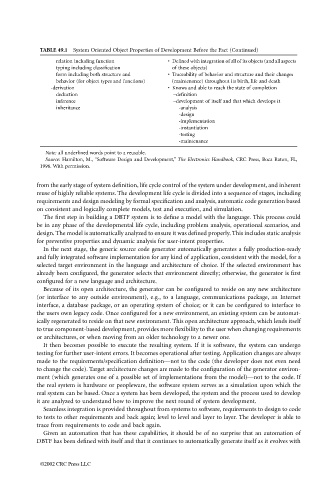Page 1218 - The Mechatronics Handbook
P. 1218
0066_frame_C49.fm Page 13 Thursday, January 10, 2002 5:05 PM
TABLE 49.1 System Oriented Object Properties of Development Before the Fact (Continued)
relation including function • Defined with integration of all of its objects (and all aspects
typing including classification of these objects)
form including both structure and • Traceability of behavior and structure and their changes
behavior (for object types and functions) (maintenance) throughout its birth, life and death
-derivation • Knows and able to reach the state of completion
deduction –definition
inference –development of itself and that which develops it
inheritance -analysis
-design
-implementation
-instantiation
-testing
-maintenance
Note: all underlined words point to a reusable.
Source: Hamilton, M., “Software Design and Development,” The Electronics Handbook, CRC Press, Boca Raton, FL,
1996. With permission.
from the early stage of system definition, life cycle control of the system under development, and inherent
reuse of highly reliable systems. The development life cycle is divided into a sequence of stages, including
requirements and design modeling by formal specification and analysis, automatic code generation based
on consistent and logically complete models, test and execution, and simulation.
The first step in building a DBTF system is to define a model with the language. This process could
be in any phase of the developmental life cycle, including problem analysis, operational scenarios, and
design. The model is automatically analyzed to ensure it was defined properly. This includes static analysis
for preventive properties and dynamic analysis for user-intent properties.
In the next stage, the generic source code generator automatically generates a fully production-ready
and fully integrated software implementation for any kind of application, consistent with the model, for a
selected target environment in the language and architecture of choice. If the selected environment has
already been configured, the generator selects that environment directly; otherwise, the generator is first
configured for a new language and architecture.
Because of its open architecture, the generator can be configured to reside on any new architecture
(or interface to any outside environment), e.g., to a language, communications package, an Internet
interface, a database package, or an operating system of choice; or it can be configured to interface to
the users own legacy code. Once configured for a new environment, an existing system can be automat-
ically regenerated to reside on that new environment. This open architecture approach, which lends itself
to true component-based development, provides more flexibility to the user when changing requirements
or architectures, or when moving from an older technology to a newer one.
It then becomes possible to execute the resulting system. If it is software, the system can undergo
testing for further user-intent errors. It becomes operational after testing. Application changes are always
made to the requirements/specification definition—not to the code (the developer does not even need
to change the code). Target architecture changes are made to the configuration of the generator environ-
ment (which generates one of a possible set of implementations from the model)—not to the code. If
the real system is hardware or peopleware, the software system serves as a simulation upon which the
real system can be based. Once a system has been developed, the system and the process used to develop
it are analyzed to understand how to improve the next round of system development.
Seamless integration is provided throughout from systems to software, requirements to design to code
to tests to other requirements and back again; level to level and layer to layer. The developer is able to
trace from requirements to code and back again.
Given an automation that has these capabilities, it should be of no surprise that an automation of
DBTF has been defined with itself and that it continues to automatically generate itself as it evolves with
©2002 CRC Press LLC

